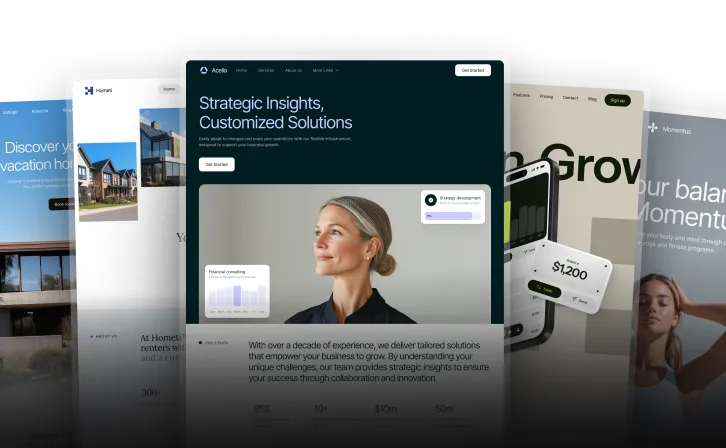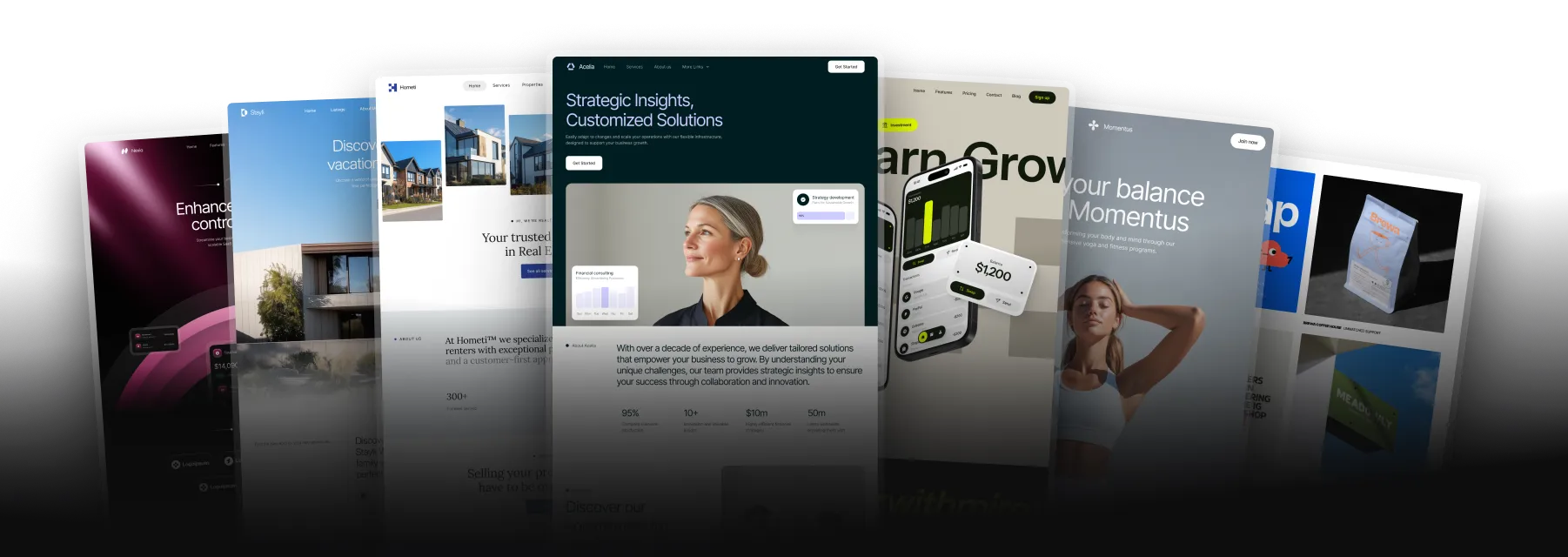Squarespace Alternative for 2025
Unlock all templates




If Squarespace feels limiting for your growing needs, consider Webflow and Framer - two platforms offering more flexibility and advanced features. While Squarespace is beginner-friendly, its template-based design, transaction fees, and limited customization might not suit larger or more complex projects.
Key Alternatives:
- Webflow: Full design control, advanced CMS, no transaction fees on higher plans. Ideal for professional designers and agencies.
- Framer: Focused on interactive and visually dynamic designs. Perfect for creative professionals and UI designers.
Quick Comparison:
| Feature Category | Squarespace | Webflow | Framer |
|---|---|---|---|
| Ease of Use | Beginner-friendly | Moderate learning curve | Advanced, steeper learning |
| Design Flexibility | Template-based | Full customization | Interactive animations |
| Pricing Entry Point | $16/month | $14/month | $15/month |
| Best For | Small businesses, bloggers | Agencies, designers | Creative professionals |
| E-commerce | Built-in, fees on lower tiers | Advanced, no fees on higher | Limited |
Who Should Choose What?
- Squarespace: Great for beginners who need a quick, simple website.
- Webflow: Best for those needing advanced design control and scalability.
- Framer: Ideal for creative projects with interactive design needs.
Want more details? Keep reading to explore features, pricing, and performance insights for each platform.
Framer vs Squarespace: Which Website Builder is Right for You in 2025?

1. Squarespace Features
Squarespace focuses on bold, personality-driven designs while keeping things user-friendly.
Design and Templates
Squarespace provides five template options tailored to different branding styles: Organic Matter, Just My Type, Visual Smiles, Vivid Glow, and Sketchbook.
Pricing Structure
| Plan | Monthly Cost | Annual Cost | Key Features |
|---|---|---|---|
| Personal | $25 | $16 | Basic website features, no eCommerce, unlimited bandwidth |
| Business | $36 | $23 | eCommerce support, 3% transaction fee, advanced analytics |
| Basic Commerce | $40 | $28 | No transaction fees, customer accounts, product reviews |
| Advanced Commerce | $72 | $52 | Advanced shipping, abandoned cart recovery, subscription services |
Mobile Responsiveness
The platform’s Fluid Engine allows users to customize mobile layouts independently. Content automatically adjusts for different devices. Web Designer David Alex shares:
"Squarespace's built-in responsive design makes it possible to build websites that look great on any device without extra code or manual adjustments".
Technical Capabilities
With over 3 million live websites, Squarespace delivers essential features across all plans, including:
- Built-in SSL security
- Free custom domain (first year with annual billing)
- Automatic image optimization
- Multiple responsive breakpoints
- SEO tools (though not as detailed as some competitors)
Squarespace’s CMS complements its focus on simplicity, making it accessible for users without technical expertise.
Content Management
The Content Management System (CMS) prioritizes ease of use over deep customization. Content Lead Arianna Frederick highlights:
"The current and anticipated trends invite designers to infuse websites with creativity and emotion, celebrating the unique voice behind each web design project".
While Squarespace works well for basic websites, its template-focused design, limited SEO options, and transaction fees may not suit users with larger or more complex needs. This often leads some to consider other platforms for more advanced projects.
2. Webflow Features

Webflow continues to shine in 2025 with its advanced design tools and flexible content management system. It offers a range of features that give designers full control over both the look and functionality of their websites.
Design Freedom and Customization
Webflow sets itself apart from platforms like Squarespace by offering unmatched design flexibility. Its visual design tool lets users create complex layouts and animations with ease. As Kristina Valcheva, Web Design Specialist at Creative Corner Studio, explains:
"With Webflow, you can create a design tailored specifically to your brand, whether you need sophisticated animations, custom fonts, or unique layouts."
Responsive Design
Webflow’s responsive design tools use fluid grids and adjustable breakpoints, ensuring websites look great on any device. The platform’s visual interface even allows real-time previews of layout changes. This is especially important as mobile devices now account for over 54% of web traffic.
Pricing Structure
| Plan Type | Monthly Cost | Key Features |
|---|---|---|
| Site Basic | $14 | 150 pages |
| CMS | $23 | 2,000 CMS items, 20 collections |
| Business | $39 | 10,000 CMS items, 40 collections |
| E-commerce Standard | $29 | 500 items, 2% transaction fee |
| E-commerce Plus | $74 | 5,000 items, no transaction fees |
| E-commerce Advanced | $212 | 15,000 items, no transaction fees |
Technical Performance
A case study from January 2025 revealed that switching to Webflow led to a 50% boost in website performance and a 30% improvement in SEO rankings.
Content Management
Webflow’s CMS supports custom content types and dynamic content management, making it a favorite for businesses looking to stand out. Eric Phung, Web Development Expert at Socialectric, highlights this advantage:
"Webflow empowers designers to bring any vision to life, making it perfect for businesses that need to establish a unique brand identity."
Template Marketplace
For those who want a quick start, Temlis offers premium Webflow templates priced between $79 and $129. These templates cover industries like SaaS and real estate, providing a professional base while still allowing full customization.
Webflow’s wide range of tools and scalable pricing make it an excellent choice for businesses that need advanced design capabilities and dynamic content options. While it may take more time to learn compared to Squarespace, its flexibility and performance often make it a worthwhile investment for businesses aiming to grow. Next, we’ll take a closer look at what Framer brings to the table.
sbb-itb-fdf3c56
3. Framer Features
Framer stands out as a 2025 alternative to Squarespace, offering designers tools for advanced customization and interactive website experiences.
Design Capabilities
Framer provides extensive flexibility, enabling users to craft highly personalized websites. Its effects and animations help create dynamic, visually engaging designs. Teodor Iliev, Founder of Wize Templates, highlights this by saying:
"Framer gives you a lot more opportunity for customizing the look of your website. Once you get the hang of it, the only thing your creativity is limited by is your imagination."
This level of customization also extends to technical control, which is detailed further below.
Responsive Design System
Framer’s responsive design system sets it apart from traditional website builders. It allows users to independently adjust desktop, tablet, and mobile views using a breakpoint system. Luca Da Corte, a Certified Framer Expert, notes:
"While Framer's editor allows for much more flexibility, it can be harder to approach for complete beginners."
This feature bridges creative design with functional adaptability, paving the way for its pricing and collaborative tools.
Pricing Structure
| Plan | Monthly Cost | Key Features |
|---|---|---|
| Mini | $5 | Basic landing pages |
| Basic | $15 | Password protection, custom domains |
| Pro | $30 | 10,000 pages, 100 GB bandwidth |
| Startup | $75 | Team collaboration features |
| Scaleup | $200 | Enterprise-grade support |
Performance and Collaboration
Framer boosts team efficiency with real-time collaboration, allowing multiple team members to work on the same project simultaneously. This feature is especially useful for design teams handling complex web projects.
Template Marketplace
Temlis offers premium Framer templates priced between $79 and $129. These templates cater to industries like SaaS, finance, and real estate, providing a professional starting point while still allowing customization.
Technical Considerations
Framer’s editor operates similarly to CSS, giving advanced users precise control over their designs. A 2024 case study revealed that a tech startup using Framer saw a 40% increase in user engagement thanks to custom animations and layouts. This technical foundation ensures Framer can deliver high-performing, modern websites tailored to today’s design needs.
Platform Strengths and Limitations
Choosing the right platform depends on understanding each one's strengths and limitations. This ensures you can match your specific needs and technical skills to the best option.
Core Platform Comparison
| Feature Category | Squarespace | Webflow | Framer |
|---|---|---|---|
| Ease of Use | Simple interface, minimal learning curve | Moderate complexity; some design knowledge helpful | Advanced, design-focused interface with a steeper learning curve |
| Design Flexibility | Template-based with limited customization | Full design control with advanced options | Focused on interactive design and animations |
| Pricing Entry Point | $16/month (Personal) | $14/month (Basic) | $15/month (Basic) |
| Best Suited For | Beginners and small businesses | Professional designers and agencies | Creative professionals and UI designers |
| E-commerce Capabilities | Built-in with transaction fees on lower tiers | Advanced e-commerce features, no transaction fees on higher plans | Limited e-commerce functionality |
These comparisons provide a foundation for exploring the unique benefits and challenges of each platform.
Key Strengths by Platform
Squarespace stands out for its beginner-friendly interface, making it easy to quickly create websites without technical know-how.
Webflow offers unmatched design control and a powerful CMS. Digital Marketing Expert Evgenii Tilipman highlights this by saying:
"Webflow provides full design control, advanced CMS capabilities, and superior performance."
Framer shines in creating visually dynamic websites, thanks to its focus on interactive design and animations. However, it’s better for creative projects rather than complex applications or e-commerce.
Cost-Benefit Analysis
Webflow’s higher-tier plans eliminate transaction fees and include advanced e-commerce tools, making it a strong choice for businesses. In contrast, Squarespace applies transaction fees on its lower-tier plans.
Template Ecosystem
Each platform has a unique approach to templates:
- Squarespace offers polished, professional designs that are easy to use.
- Webflow provides a wide range of fully customizable templates.
- Framer features a growing library, including contributions from providers like Temlis.
Technical Support and Resources
Support options vary by platform:
- Squarespace focuses on straightforward tutorials for beginners.
- Webflow offers extensive learning resources through Webflow University.
- Framer provides documentation tailored to its design-focused tools.
These resources ensure users can maximize each platform's capabilities, regardless of their expertise level.
Conclusion
Here’s a clear framework to help you decide which platform fits your needs best.
In 2025, each platform serves a specific audience. Squarespace is perfect for small business owners, bloggers, and entrepreneurs who want a professional website without dealing with technical hurdles. Its easy-to-use interface and built-in features make it a go-to option for those seeking simplicity.
Webflow, on the other hand, is designed for agencies and professional designers who need more control over design. With the ability to manage over 100,000 CMS items, it’s a solid choice for content-heavy websites and businesses planning for growth.
Framer shines when it comes to visually striking marketing sites and interactive designs. It’s a favorite among creative professionals and UI designers. However, its limited CMS and e-commerce options mean it’s not the best fit for businesses needing a more comprehensive website.
Here’s how to decide:
- Squarespace: Ideal if you want to launch quickly, need built-in marketing tools, and don’t require extensive customization.
- Webflow: Best for those needing advanced design control, robust CMS features, and scalability - especially if you have technical expertise or are willing to learn.
- Framer: Great for interactive designs, marketing sites, and landing pages, especially if modern design workflows are your priority.
These platforms offer varying levels of design flexibility, content management, and responsiveness. For instance, Website Builder Expert rates Squarespace highly at 4.6/5 for value. Meanwhile, Webflow’s CTO Allan Leinwand highlights its scalability, stating, “Webflow is built to scale, and we’re continually pushing the limits of what’s possible”.
Ultimately, your choice should align with your technical skills, budget, and future goals. Take advantage of free trials to explore your options before making a commitment.
Related Blog Posts
Recommended posts
Unlock all templates







